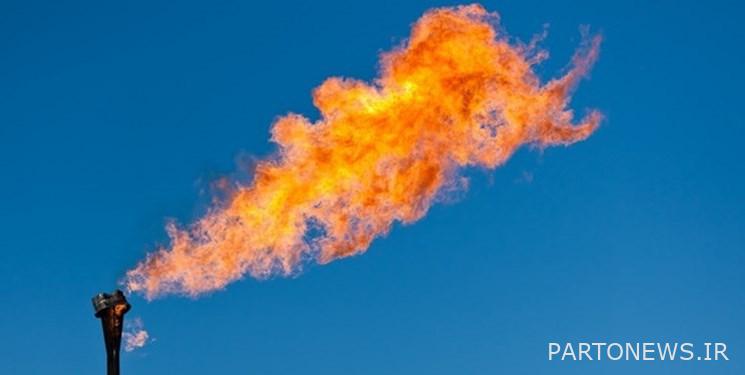Zero to one hundred liquefaction of liquefied natural gas in oil refineries / More than 200,000 tons of LPG burned

According to the economic correspondent of Fars News Agency, liquefied petroleum gas (LPG) consists of two hydrocarbons, propane and butane, which are produced in oil refineries and gas refineries.
Liquefied petroleum gas is produced in oil refineries alongside gasoline, diesel and other petroleum products. According to the Ministry of Petroleum, the production of liquefied natural gas in oil refineries is about 2.4 million tons per year.
Jalil Salari, CEO of the National Company for Refining and Distribution of Petroleum Products in this regard SaysAt present, the total annual LPG production in oil refineries is 2.4 million tons, of which 1.8 million tons are used domestically for domestic consumption in areas without gas piping and the rest is exported.
The main production of liquefied natural gas in gas refineries is related to the South Pars complex, which is extracted from gas fields along with natural gas and gas condensate, and the production capacity of this product is estimated at 10 million tons per year from gas refineries.
Developments in the global liquefied natural gas market and export restrictions due to oil sanctions have prevented the sale of part of Iran’s liquefied natural gas. According to various documents, at least 3 million tons of liquefied natural gas of the South Pars complex have been wasted and burned in pipelines and flares since 1997.
However, the scope of liquefied natural gas loss is not limited to gas refineries, but according to documents available to Fars News Agency, this valuable fuel is also wasted in oil refineries due to export restrictions.
In the following, we will investigate the loss of liquefied natural gas in 7 oil refineries of the country, referring to the correspondence made with the National Company for Refining and Distribution of Petroleum Products in 1399-1400.
* Loss of 40% of Isfahan refinery liquefied natural gas production
Isfahan Oil Refining Company states in a letter dated 14/01/1400 that the daily production of liquefied natural gas in this refinery is 1500 tons per day and due to the filling of all liquefied gas storage tanks, 40% of this fuel (600 tons per day) is currently burning. .
Then the company announces in another letter on 23/1/1400 that on some days all the produced liquefied petroleum gas is injected into the refinery’s gas fuel circuit and the harvest of this product has not increased yet (due to export restrictions due to sanctions). The letter also emphasizes that currently between 6000-7000 barrels per day (more than 40% of production volume) of liquefied natural gas is being burned.
Isfahan Oil Refining Company also states in another letter dated 01/28/1400 that it continues to burn large volumes of liquefied natural gas due to restrictions and full tanks. The letter states: The average production of liquefied natural gas in the first 27 days of this year was 1450 tons and the average harvest of this product was 980 tons, and in addition, it was injected into the refinery fuel circuit.
In another letter dated 02/20/1400, the company states that there has been no change in the liquefied natural gas extraction from the refinery and that the process of losing this valuable fuel continues due to the fullness of the tanks.
If it is assumed that the problem of burning liquefied petroleum gas of Isfahan refinery has been solved by the end of May and only in the first two months of the year, equivalent to 600 tons of liquefied petroleum gas (40% of production) is wasted daily, Thus, the volume of liquefied natural gas wasted at the Isfahan refinery this year was about 36,000 tons.
* Daily loss of 330 tons of liquefied gas in Abadan refinery at the beginning of 1400
Abadan Oil Refining Company announces in a letter dated 12/27/1399 that 2700 tons of liquefied natural gas has been burned in the refinery’s fuel ring from March 7 to 10 due to insufficient harvesting. According to the letter, at least 350 tons per day must be added to the Abadan refinery liquefied natural gas extraction, otherwise this amount of liquefied petroleum gas will be wasted in the future.
The company states in another letter dated 1400/01/28 that in the last 10 days, about 3300 tons of liquefied gas have been lost in the refinery fuel ring (average daily 330 tons).
Abadan Oil Refining Company states in a letter dated 1400/02/07 that from the beginning of March 2016 to 1400/02/05, about 79500 tons of liquefied gas has been produced in this company and the amount of extraction in the same period has been about 60700 tons. Indicates 18,800 tons of injection of this product into the refinery fuel system.
We assume that 10 days after the last letter, the company’s liquefied natural gas problem has been completely solved. As a result, with a simple proportion, the amount of liquefied gas lost in the Abadan refinery due to export restrictions was about 22,000 tons.
* Loss of butane in Bandar Abbas refinery due to filling storage tanks
Bandar Abbas Oil Refining Company in its letters dated 01/31/1400 has stated that the final inventory of liquefied gas tanks in Bandar Abbas refinery is about 4200 tons and the empty space for storage is about 650 tons. Also, the approximate average production of liquefied gas was 540 tons per day and the average harvest was 490 tons per day in April 1400. The refinery also sent a similar letter to the National Petroleum Products Distribution Company on 02/02/1400.
In another letter dated 12/2/1400, the company stated that the reserves of the tanks have been reduced from 650 tons to 430 tons. Also, the stock of butane tanks will be filled within the next 24 hours, after which the excess butane will inevitably be burned. Bandar Abbas Oil Refining Company has stated in a letter dated 02/03/1400 that the level of reservoirs has been reduced to 160 tons.
In general, according to the correspondence, the loss of propane at the Bandar Abbas refinery has not been raised, although the loss of butane in this unit has been very probable this year. The gradual decline in liquefied natural gas reserves of this refinery shows that there are serious problems in Iran’s liquefied natural gas exports.
* Burning 100,000 tons of liquefied gas in the Persian Gulf Star refinery in 5 months
Persian Gulf Star Oil Company has stated in letters dated 12/16/2016 that the average liquefied natural gas extraction by the National Broadcasting Company is not commensurate with the average production of 1000 tons per day and 467 tons equivalent to 50% of the refinery liquefied natural gas production is extracted daily. . As a result, the company has been forced to burn valuable liquefied petroleum gas products in the fuel unit due to restrictions on liquefied petroleum gas storage in tanks.
The company mentioned in a letter dated 1400/01/08 that the average daily liquefied natural gas extraction from the refinery was 370 tons in April, while the daily production of liquefied natural gas is 1000 tons. It has also been emphasized that the Persian Gulf Star Oil Company has been forced to burn valuable liquefied petroleum gas products in the fuel unit since the beginning of 1400 (Table 1).
Table 1- Table attached to the letter 1400/01/08 Persian Gulf Star Oil Company
Persian Gulf Star Oil Company in its letters dated 02/01/1400 has announced the average daily liquefied gas extraction in April 1400 as 780 tons, while the daily production is more than 1200 tons in April. As a result, the rest of the liquefied petroleum gas is burned and wasted.
Also, according to the letter dated 02/18/1400, the amount of liquefied natural gas production of the Persian Gulf Star Refinery in May of this year was more than 1000 tons per day, but the extraction of this fuel was only 542 tons per day and the rest of the produced liquefied natural gas was burned.
If it is assumed that in the most optimistic case, the problem of liquefied gas extraction of this refinery will be solved by the end of May, thus, with the passage of the cold season in 1999, In total, about 43,000 tons of liquefied petroleum gas from the Persian Gulf Star Refinery were wasted in the three months of March 1999, April and May 2014.
Of course, the problems of liquefied gas loss are not limited to this year, but for example, according to the documents received, the production of liquefied natural gas at the Persian Gulf Star Refinery in June 1999 was about 1200 tons per day, but this fuel was harvested only 430 tons per day. Also, the amount of liquefied gas extraction of this refinery in July of 1999 was less than 5% of production. As a result, with a thumb calculation, the amount of liquefied gas lost at the Persian Gulf Star Refinery in the two months of June and July 1999 was about 57,000 tons.
In total, in the 5 months mentioned in the letters, about 100,000 tons of liquefied natural gas from the Persian Gulf Star Refinery have been lost.
* Details of liquefied gas loss of Shazand Arak refinery in 1999
Imam Khomeini Shazand Oil Refining Company has stated in letters dated 1400/01/07 and 1400/02/05 that due to the lack of proper harvesting for liquefied gas production, part of this product has been burned in the company’s furnaces and part of it has been forced to The refinery burners are guided.
Table 2 shows the rate of liquefied gas loss in this refinery in 1999. Thus, by converting the volume to mass, the amount of liquefied gas loss (furnace fuel + flirting) of Shazand refinery in 1999 was about 21,000 tons.
Table 2- Shazand refinery liquefied gas (unit: liter)
* 400 tons of liquefied natural gas are wasted daily in Tehran refinery
Tehran Oil Refining Company has stated in the letters dated 02/13/1400 that due to the accumulation of liquefied petroleum gas products in the refinery storage tanks due to insufficient harvest in proportion to production, liquefied gas has been injected into the fuel network of Tehran refinery according to Table 3.
Table 3
If the daily loss of 400 tons in the Tehran refinery has continued from the beginning of 1400 to the end of May, it is estimated that about 24,000 tons of liquefied natural gas in this refinery has been burned due to harvest restrictions (due to export restrictions).
* Lavan refinery warning about filling liquefied gas tanks in June 1400
Lavan Oil Refining Company has stated in the letters dated 1700/03/1400 that the recoverable inventory of the company’s liquefied natural gas product is more than 7140 cubic meters (3850 tons) and 230 cubic meters (125 tons) is added to the inventory daily. As a result, LPG storage tanks will be filled in up to 3 more days.
Although no other information is available on the status of the refinery liquefied petroleum gas, it seems that regardless of the amount of waste, part of the liquefied petroleum gas produced by this refinery has also been lost.
* Loss of at least 200,000 tons of LPG in the first months of the year
In total, a review of the same number of letters and documents received shows that at least 200,000 tons of liquefied natural gas from 7 oil refineries in the country are wasted annually in the first 2-3 months of the year. Considering the price of liquefied natural gas equivalent to $ 500 per ton in the warm months of the year, the country’s non-profit in 2-3 months of this year has been about 2.5 thousand billion tomans.
What was presented in this report refers to documents whose details are kept with Fars News Agency, but it is predicted that the loss of liquefied natural gas in the country’s oil refineries will be more than the amount given in this report. The National Company for Refining and Distribution of Petroleum Products has not yet published a comprehensive report on the amount of liquefied petroleum gas lost in refineries.
Prior to the publication of this report, Fars News Agency had published several documents about the loss of liquefied natural gas in the South Pars complex, which can be found at (Link 1، Link 2، Link 3) Is visible.
End of message /

